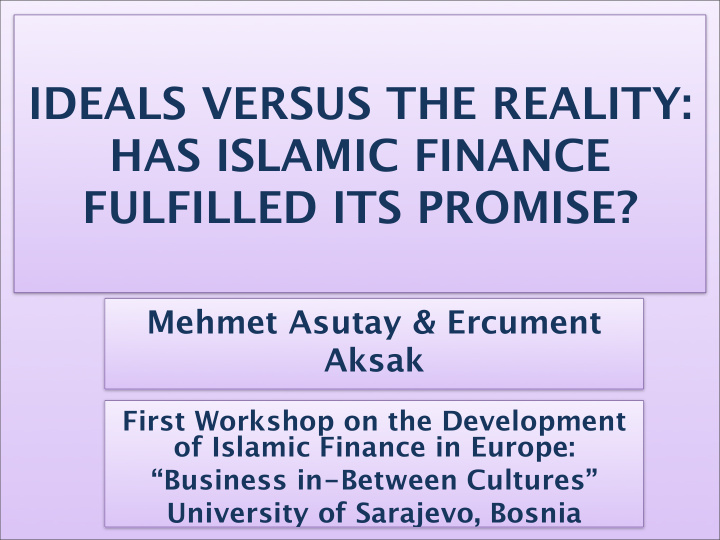



IDEALS VERSUS THE REALITY: HAS ISLAMIC FINANCE FULFILLED ITS PROMISE? Mehmet Asutay & Ercument Aksak First Workshop on the Development of Islamic Finance in Europe: “Business in-Between Cultures” University of Sarajevo, Bosnia
Islamic Finance as a Rising 1980-2000 1970-1980 2000-2010 BIRTH EMERGENCE EXPANSION •Commercial Islamic •Commercial Islamic •Commercial Islamic Banks Banks banks •Islamic investment •Islamic investment companies companies •Islamic Insurance •Islamic insurance companies companies •Islamic investment banks •Islamic asset management •Islamic retail banks •Islamic brokers •Islamic internet
Islamic Finance as a Rising • By 2010 655 IB&F institutions were operating in 55 countries (The Banker, 2010) • IB&F industry has passed the 1 trillion USD market size and one of the fastest growing sectors in global economy
Impressive Economic • Economies of Muslim nations have achieved considerable growth: – S. Arabia, Indonesia and Turkey are among the largest 20 economies globally (G-20) • Economies of Muslim nations have achieved wealth and prosperity: – Qatar, U.A.E. and Kuwait are among the top 20 globally for per person income • East Asian (Malaysia and Indonesia) and current global crisis (i.e. Sukuk default in Dubai) have contradictory evidence):
A Success Story? • Islamic economics emerged as a reaction to the failure of conventional economic growth policies • The aim was to achieve human development and well-being both in moral, spiritual and material dimensions • Founding axioms underlying Tawhid, Justice, Morality, Prudence and
Aspirations of Islamic • A just economic system based on the moral and ethical values of Islam – promoting economic activity – avoids uncertainty and risk and protects wealth – encourages entrepreneurship and trade – aiming at the well-being of the humans and societies through growth and development
Islamic Finance in Islamic • Expectations from Islamic finance as a tool of Islamic economic aspirations: – Stronger, more sound financial markets encourage participation from investors outlined before – Financial activity with minimised uncertainty, risks and speculation – Better links with the “Real Economy” – Financial support for trade and economic growth
Stronger and Safer Financial
Stronger and Safer Financial
Stronger and Safer Financial
Stronger and Safer Financial • No strengthening e fg ect – Conventional and Islamic indices move in parallel and very closely correlated – almost mimicking • No conclusive evidence for additional safety – No apparent di fg erences in the volatility of returns
Better Ties to the Real
Better Ties to the Real
Better Ties to the Real
Better Ties to the Real • Much stronger ties to the conventional financial markets than the “Real economy” and excessive volatility compared to real economic activity – Size disadvantage: Islamic finance is still smaller – Tendency of Islamic finance investors to use the conventional markets as a benchmark for their diversification purposes – Evidence that Islamic finance has become a part of pro-cyclicality of financial markets. Can be protective during bull markets, but counter-productive during crisis
Support for Economic
Support for Economic
Support for Economic
Support for Economic • Severed links with general economy • Growth of Islamic bank assets far exceeds economic growth, especially before economic crisis • Excessive growth before crisis suggests a speculative asset bubble similar to the characteristics of
Islamic Banks and Funding
Islamic Banks and Funding (2)
Islamic Banks and Funding (3)
Islamic Banks and Funding (4) • Financial services & banking, real estate and consumer funding takes the largest share • “Others”, as an umbrella group has also an important share • However, trade, manufacturing and transportation do not seem to be on
Development beyond Growth • El-Ghazali: – “.... the whole concept of development needs to be reviewed in order to incorporate human ...needs and not just the rates of growth...” • United Nations Human Development Index:
Development beyond Growth (2) • Total Factor Productivity as an indicator for innovation and knowledge creation
Concluding Remarks • Islamic finance, despite its impressive growth performance, is still a small branch of global financial markets • Despite the e fg orts on standardization, disclosure, regulation and governance improvements as well as implementation of sophisticated risk management techniques, Islamic finance still has a long way improve in these areas • Developments in IB&F have so far failed to fulfil the aspirations and ideals of Islamic economic thought, with regards to the ties with the real economy
Thank you Questions?
Recommend
More recommend